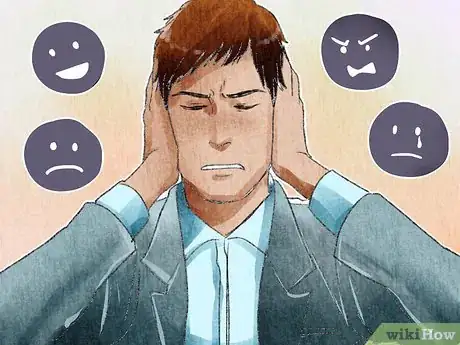This article was co-authored by Trudi Griffin, LPC, MS. Trudi Griffin is a Licensed Professional Counselor in Wisconsin specializing in Addictions and Mental Health. She provides therapy to people who struggle with addictions, mental health, and trauma in community health settings and private practice. She received her MS in Clinical Mental Health Counseling from Marquette University in 2011.
There are 57 references cited in this article, which can be found at the bottom of the page.
wikiHow marks an article as reader-approved once it receives enough positive feedback. This article received 11 testimonials and 94% of readers who voted found it helpful, earning it our reader-approved status.
This article has been viewed 775,566 times.
Have you been finding that you cry at the drop of a hat? Get angry unnecessarily? Maybe you just feel nervous all the time. Whatever you may be feeling, you should begin by understanding that experiencing emotions is a normal part of human living. There is nothing inherently “wrong” with any emotion.[1] You do not have to eliminate or ignore your feelings to handle them.[2] Becoming emotionally stronger is much like building physical strength. Begin slowly, be consistent, build endurance, and keep it up.
Steps
Coping in the Moment
-
1Stop what you’re doing and re-focus. In the heat of an emotional moment, it can be easy to get swept up by what you’re feeling. If the emotion is positive, it can feel great, but if it is a feeling of sadness or anxiety, it can quickly spiral out of control. Take a break from whatever is going on and focus on your body’s five senses. This will help remind you of the present, and can help anxiety or anger from storming out of control.[3]
- Try taking stock of your body’s reactions, but don’t judge them. For example, if you’re feeling anxious all of a sudden, think about what your body is feeling. “My skin feels hot. My heart is beating really fast. I am breathing shallowly. My hands feel shaky.” Don’t focus on these feelings. Just notice them and then let them pass.[4]
- Refocusing on your present moment may also help you reduce “automatic reactivity.” Your brain forms habits of reacting to stimuli, including emotional experiences. The brain instantly activates these patterns whenever that stimulus, such as anxiety or anger, occurs. Shifting your focus back to your present sensory experience breaks that circuit in your brain. If you practice this shifting consistently, it will become a new “habit” for your brain.[5]
- “Self-observation,” the practice of paying attention to your own mind’s awareness and experience, can help you tease out the multiple things that may be happening within a single experience. For example, many people are unaware that “awareness” actually consists of many information paths. Often, we experience an emotional reaction as a jumble of feelings and sensory experiences that can feel overwhelming. Slowing down and refocusing on some experience in the present, such as what you’re seeing, hearing, and smelling, can help you restructure your brain’s old habits and learn to see these different “information streams.”[6]
-
2Breathe. When your body experiences an intense emotion, it can react with a “stress response.” This “fight or flight” feeling happens when your sympathetic nervous system is activated by hormones like adrenaline. Your heart rate skyrockets, your breathing gets faster and shallower, and your muscles feel tight and tense.[7] Breathing deeply can help relax you and help you return to “normal.”[8] [9]
- Breathe from your abdomen, not your chest. You should feel the lower part of your belly expand when you inhale and fall as you exhale.[10]
- To help you, place one hand on your chest and the other on your abdomen. Stand upright, lie flat, or sit straight to keep your chest open. Inhale slowly and deeply through your nose. Feel your lungs and abdomen expand as you breathe in. Then, exhale through your nose or mouth. Aim for 6-10 deep breaths per minute.[11]
- Focus on taking slow, deep breaths. This will provide oxygen to your body (and help distract you from your current emotional state).[12]
Advertisement -
3Smile. It may seem cheesy at first, but research has showed that the act of smiling can actually make you feel more positive.[13]
- Smiling can also decrease stress. Try to smile using all your facial muscles, not just the ones around your mouth. Smiles that spread across your face and up to your eyes feel more natural, which increases your body’s feeling of positivity.[14]
-
4Use visualization. Visualizing a calming, relaxing experience can help you regain control over your emotional responses.[15] You may find that this technique takes a little practice, but it can help you transform stressing thoughts into thoughts you feel more comfortable handling.[16]
- Begin by choosing your “safe place.” This can be any place you can imagine that you find relaxing and peaceful. It could be a beach, a spa, a mountaintop, or any place you think will help you feel safe and relaxed.
- Find a place to practice visualization. If you can, find a quiet, comfortable place to use your visualization. It should be a place where you will not be interrupted for a few minutes.
- Close your eyes and imagine yourself in your safe place. Imagine what it looks like. What is going on there? What does it smell like? What sounds do you hear? Try to immerse yourself in your safe place.
- Breathe slowly and evenly. Try to relax muscles if you feel they’re tense. If you feel awkward or anxious, don’t judge yourself for that. Just try to imagine yourself in your calming place and what it feels like to relax.
- Imagine your negative emotion as a physical object. You may feel strange trying this at first, but keep with it. Imagine that negative feeling as something that you can remove from your visualized safe place. For example, you might imagine that your anger is a flame. Flames can’t burn without oxygen. Imagine that anger as a flame and watch it as it sputters out. Or, you could imagine a feeling of stress as a stick. You can throw that stick far away from your safe beach and imagine that stress leaving you as it goes.
-
5Learn how to manage stress. When you get stressed out, you may find that don’t have as much control over your emotions. While it is nearly impossible to cut all stressful things from your life, you can learn how to deal with the stress that those things create. Some ways to calm yourself in really stressful situations include:[17]
- Taking five deep breaths. Breathe in through your nose, hold the air in your body for a moment, and then out through your mouth. Focusing on your breath will help you gather yourself and calm your nerves.
- Counting to 10. If something stressful happens, give yourself 10 seconds to gather yourself. To extend the length of time, count ‘one Mississippi, two Mississippi, 3….etc.’
- Walking away from the situation. Doing this does not mean you will not handle the situation--it simply allows you to get away, breathe, and consider the options. If you are dealing with a person who is stressing you out, tell him or her that you need a moment to collect your thoughts and that you are going for a walk.
-
6Learn to recognize cognitive distortions. In the moment, it can be easy to get caught up in habitual ways of responding to an emotion, even when they’re unhealthy. These responses often work together to leave you feeling loaded down by your feelings. Learning to recognize some common “traps” that you might fall into can help you become more emotionally resilient. Catastrophizing, overgeneralizing, and all-or-nothing thinking are three common distortions.
-
7Recognize and challenge Catastrophizing. This happens when an event or experience -- usually insignificant -- gets blown out of proportion. Your thoughts begin to spiral out of control until you end up at the absolute worst-case scenario. This can lead you to feeling angry, sad, or anxious.
- For example, imagine that you call your romantic partner and s/he doesn’t answer the phone. You call back in a few minutes and get voicemail again. A catastrophizing thought might start snowballing: “S/he isn’t answering the phone. S/he’s probably mad at me. I don’t even know what I did wrong. S/he isn’t telling me what I did wrong. S/he doesn’t want to talk to me. Maybe s/he is bored with me.”
- Challenge catastrophizing thoughts by not letting your mind jump from one thought to the next until you’ve examined the evidence for your assumption. For example, in this example, a good challenge could look like this: “My partner isn’t answering the phone. S/he wasn’t mad at me earlier today, so s/he probably isn’t mad at me now. If s/he is, I can ask her/him about it later and talk things through.” You could also remind yourself that people have many logical reasons for not answering the phone at any particular moment: being occupied, driving, not seeing/hearing the phone, etc.
-
8Recognize and challenge Overgeneralization. Overgeneralizing happens when you make a general statement about a specific situation. This can lead you to holding unhealthy (and inaccurate) beliefs about yourself.
- For example, imagine that you are not offered a job after having an interview. A generalizing view of this could be something like, “I’m such a loser. I really screwed up that interview. I’m never going to get a job.”
- Challenge overgeneralizing thoughts by sticking to the evidence and specifics. You have no evidence to suggest you’re a “loser.” The usual reasons for not getting a job are that your skills aren’t the right match for the company, or your personality might not mesh with others there. Maybe you did botch the interview, maybe you didn’t. This specific incident, however, does not apply to every facet of you as a person. Think about the situation as specifically as possible, and focus on what you can do to change the specifics in the future: “I don’t think I did a great job at that interview. I was really nervous. Next time, I will practice with a friend before I go in for an interview.”
-
9Recognize and challenge All-or-nothing thinking. With all-or-nothing thinking, you don’t allow yourself (or, sometimes, anyone else) to land in the middle. If things are not perfect, they’re a failure. All-or-nothing thinking can make useful critique hard to handle. It can also lead you to feel sad or worthless about yourself because you’re holding yourself to an impossible, unproductive standard.
- For example, consider that you are on a diet. You go out for lunch with a friend, and you end up having a piece of cake for dessert. An all-or-nothing response would see this as a failure, and could lead to harsh judgments of yourself: “I totally blew my diet with this cake. I knew I couldn’t handle this new plan. I guess I should just eat anything I want.”
- Challenge all-or-nothing thinking by treating yourself compassionately. Would you harshly judge a friend for eating a slice of cake? Unlikely. So why would you do that to yourself? Avoid looking success as either/or, where everything has to go perfectly to achieve success. Try looking at success as and, an ongoing process of growth and change: “I ate that piece of cake, which won’t help me with my diet goals, and this isn’t a catastrophe. I’ll eat a healthy dinner to get myself back on track.”
Knowing and Loving Yourself
-
1Accept vulnerability. Developing emotional strength is not the same as becoming invulnerable. In fact, vulnerability is crucial in developing your ability to connect with others and to fully experience and accept yourself.[18] Vulnerability means being open to experiences, and also accepting that they may not work out as you hope.
- Without vulnerability, it is hard to be open to experiences that have a fundamental element of uncertainty to them, such as love, trust, creativity.[19]
- Try to reject perfectionism. Perfectionism is often confused with healthy ambition or a desire for excellence. In reality, perfectionism often comes from a fear of vulnerability, the desire to “be perfect” so that we don’t experience loss or fear. Perfectionism holds you to an impossible standard and demands that you get others’ praise. Vulnerability will allow you to strive for success and achievement while understanding that setbacks happen.[20]
-
2Discover your core beliefs. In order to become stronger emotionally, you have to understand what your thoughts about yourself and the world are. These thoughts have grown up over time and shape your emotional responses. Sometimes, core beliefs are too rigid and can hold you back from developing emotional strength.[21]
- Look for beliefs that use words such as always or never. Most situations in life are somewhere on a scale. Maintaining core beliefs that rely on all-or-nothing thinking can keep you stuck trying to live up to an impossible standard.
- For example, consider how you believe about responsibility. Do you believe you are responsible for your actions and behavior? That’s healthy and helpful. Do you also believe you are responsible for others’ actions and behavior? It’s common to believe that we have the responsibility to manage the experiences and behavior of everyone around us as well as our own, but that’s actually a fallacy.
-
3Examine the “shoulds” in your life. The phrase "shoulding on yourself" was invented by psychologist Clayton Barbeau to describe the cognitive distortion of feeling like you are obligated to do something. It usually happens when you compare your actions or feelings to an external standard.[22] When you use “should” statements, you can end up feeling guilty and ashamed of yourself, instead of having the energy to change your behavior in ways that satisfy your values. When faced with “should” thoughts, examine why you feel like you “should” do this or that. [23]
- For example, if you are considering going on a diet because you “should” lose weight, think about why you “should” do that. Is it because you have a particular health goal in mind? Has your doctor talked with you about your weight? Do you want to look a certain way? Or do you feel this “should” because you feel pressured by others to look or behave a certain way?
- Society often pressures individuals with many “shoulds” that we may feel we need to conform to: You should look like the people in magazines. You should wear a certain clothes size. You should have a lot of/no sex. You should be happy. You should be a “good” partner/parent/sibling/student/employee/employer. Giving in to that pressure from others, rather than doing things for ourselves because they align with our values, can leave us feeling emotionally wiped out.
-
4Practice self-compassion. Sometimes, people feel emotionally weak because fears have crowded out other thoughts about themselves, such as being worthy of love, acceptance, and happiness. These fears contribute to anxiety (“Will others accept me?”) and depression (“I’m not worth anything”). Practicing self-compassion will help you learn to love and accept yourself, and that will make it easier for you to become stronger in your emotional interactions with others. According to psychologists, self-compassion involves three elements: self-kindness, common humanity, and mindfulness.
-
5Practice Self-kindness. This is the opposite of self-criticism. We’re often taught to strive for perfection, and that a lack of perfection is a failure. However, it's much kinder to view yourself (and others) as a "work in progress." Research has actually showed that perfectionism can hold you back from true achievement.[24] [25]
- Emotional strength comes from extending to ourselves the same understanding that we would to a friend. After all, if a close friend made a mistake, you would probably acknowledge the wrongdoing but still respond with forgiveness and love. Try doing this for yourself, too.
-
6Acknowledge Common humanity. This is the opposite of self-isolation. It can be easy to believe that we are the only ones who have experienced pain from our mistakes and life experiences, as though nobody else has experienced the same grief or done something as wrong as we have. Acknowledging your common humanity means recognizing that pain and suffering are part of the shared human experience, and that allows you to approach your own experiences with less judgment.[26]
- For example, it can be easy to lapse into negative self-talk that isolates you and your experience from others, e.g., "Nobody could ever be interested in me because I'm such a failure." This language unfairly totalizes: you are not "a failure" simply because you may fail at something. It also does not acknowledge that everyone fails from time to time. It holds you to a higher standard than anyone else, which isn't fair to you (or them).[27]
- Instead, try reframing this self-talk. "I did not accomplish such-and-such a goal when I had planned to. Everyone has setbacks from time to time, including me."
-
7Practice Mindfulness. Mindfulness is the opposite of self-absorption. Rather than getting stuck in a cycle of denying or focusing on negative emotions, mindfulness allows you to recognize and accept all of your feelings, without judgment, as you experience them.
- For example, if you frequently experience the thought, “I’m so unattractive, nobody will ever want to be in a relationship with me,” try reframing it through a mindfulness lens: “I am experiencing the thought that I’m unattractive. This is just one of many thoughts and feelings that I’ll experience today.”
- Another good technique is to practice mindfulness meditation. This type of meditation is focused on being “unconditionally present,” i.e., aware and accepting of what is going on at that moment. It can help alleviate anxiety and can help you be more aware of how you experience yourself.[28]
- The UCLA Mindful Awareness Research Center offers free guided meditations to download online.[29] These are organized according to situation -- body awareness, sleep preparation, etc. -- and run between 3 and 19 minutes. There are also several mobile apps, such as Calm, that provide guided mini-meditations.
-
8Identify your “best possible self.” Several studies have shown that visualizing your “best possible self” increases feelings of positivity and well-being. Identifying your best possible self requires two basic actions: visualizing the "future" you that has achieved your goals, and considering what characteristics you will need to employ (or develop) to get you there.[30]
- Start by imagining a time in the future where you are the “you” that you want to be. Consider what would be the most meaningful developments to you. (It’s important that this is the self you want to be, not one you feel pressured or like you “ought” to be.)
- Visualize your best possible self in a positive way. Imagine all the details of the situation. You can think of this as imagining a life dream, a milestone, or other big goal for yourself. For example, if your best possible self is an entrepreneur with her own successful business, imagine what that looks like. How many employees do you have? What type of boss are you? How much do you work? What do you sell or invent?
- Write down the details of this visualization. Think about what characteristics your best self is using in this imagined scenario. For example, if you are running a business, you will likely need creativity, problem-solving, networking skills, and perseverance.
- Think about what characteristics you already have. You'll probably surprise yourself! Then, think about which characteristics need further development. Imagine ways you can build those skills and traits.
- It’s very important that this does not turn into an exercise in self-judgment. Don’t judge yourself for where you are now! Instead, imagine you are who you wish to be.
-
9Don’t take things personally. You cannot control others’ thoughts or actions, but you can control your own reaction to them. Remember that much of the time, what others say or do is not about you, it’s about them and a projection of their own reality. Taking things personally gives others power over you that they should not have.[31]
- “Personalization” is a common cognitive distortion. It happens when you interpret anything that happens to you as a direct, personal response to something about you. This can lead you to feeling that others “have it in” for you. It can also lead you to take responsibility for things you are not responsible for.
- For example, if someone cuts you off in traffic, you can choose to take it personally and stew over how rude the driver was to you. Or you can interpret it as your fault for “allowing” it to happen. These are both personalizing responses that are unhealthy. A stronger response would be to remember that you are not in control of that driver’s behavior or actions, and you don’t know why s/he did what s/he did. Maybe the driver is having a bad day. Maybe they don’t care about others’ feelings. You did not cause this behavior.
- Not taking things personally doesn’t mean you can’t feel hurt by what others say. However, refusing to take something personally will help you distance yourself from the immediate negative reaction.
Establishing and Keeping Healthy Habits
-
1Start each day with self-affirmations. It may seem corny to you at first, but repeating self-affirmations to yourself will help you practice self-compassion. As you brush your teeth or get ready for work, repeat a mantra that is meaningful to you and expresses kindness to yourself.[32]
- For example, you might say something like, “I accept myself today for who I am” or “I love myself completely.”
- If you have particular areas of weakness, such as anxiety or body image issues, try focusing your self-affirmations on those. For example, if you experience frequent anxiety, a helpful self-affirmation might be “I will do the best that I can do today. I cannot do more than my best. I cannot control others’ actions.” If you experience body image issues, try finding something positive to focus on: “I will be kind to my body today, because I deserve kindness” or "I look happy and healthy today."
-
2Develop your confidence. Confidence is key when becoming emotionally stronger. Being confident in the fact that you are a unique and worthy individual will help you feel more in control of your emotions. When something bad happens, remind yourself that you have the ability to overcome this obstacle, whatever it may be.[33]
- Remind yourself that even the difficulties you have gone through are learning experiences. You can draw strength and courage from knowing that you have made it through tough times, and you can do it again.[34]
- Make a list of things you like about yourself. These could be skills, personal strengths, achievements...anything. Don't minimize your abilities and good qualities. If you're having trouble thinking of things, ask a friend to help you. They probably see many wonderful things about you that you might not even be aware of.[35]
- Set yourself a (reasonable) challenge to accomplish. For example, you could learn to cook a meal for your friends, or learn a few new poses in yoga, or learn to take artsy photographs. If you love to exercise, train for a 5k or 10k. Once you have accomplished this goal, celebrate it! Honor your successes, no matter how small they may seem to you.
- Don't compare yourself to others. This is a surefire way to damage anyone's self-confidence. Only you are the unique person who is you. The only person whose approval you need to seek is yours. Set goals that matter to you, and don't worry if they're not the same as everyone else's.[36]
-
3Take care of your physical health. Your physical health can directly affect your emotional health, and vice versa.[37] Caring for your physical health can help you feel less stressed. It can also increase your feelings of well-being and make it easier for you to handle your emotions.[38]
- Exercising is an important part of staying emotionally healthy. When you exercise, your body releases endorphins that make you happy. Next time you find yourself getting upset, go on a walk, run, or to the gym. Studies have shown that regular, moderate exercise makes you feel calmer and happier.[39]
-
4Enhance your emotional “stamina.” You can develop emotional strength by focusing on positive emotions such as compassion and gratitude.[40] Maintaining a compassionate, grateful attitude will help you understand that many of your fears and anxieties are shared by others. This will allow you to be kind to yourself and to others.
- Research has shown that people who regularly practice active gratitude are more resilient in handling trauma.[41] It can also help you interpret even the suffering and negative things in life as learning and survival experiences that have contributed to the self you are now. Gratitude can help keep you from judging others.[42]
- Gratitude is more than feeling grateful. We often cannot control what feelings appear. Trying to control those feelings can overwhelm us. Instead, gratitude is an active exercise in recognizing and savoring the positive.[43] Keeping a gratitude journal, learning prayers of gratitude in your spiritual tradition, and stopping to savor a beautiful or positive experience can all help you practice gratitude.[44]
-
5Exercise empathy. Exercising empathy for others can help you build stronger, healthier relationships. It can also help you develop healthier ways of dealing with your own emotions and feelings.[45]
- Studies have shown that “loving-kindness” or “compassion” meditation can be a good way to exercise your empathy muscles.[46] Compassion meditation not only enhances your feelings towards others, it has also been shown to decrease depressive symptoms.[47] There are many ways to practice compassion meditation, although several methods stem from Buddhist traditions.[48]
- Read novels. Fiction can encourage you to imagine what it would be like to experience emotions and situations unlike you own. Some studies suggest that reading novels can increase your ability to empathize with others.[49]
- Avoid jumping to conclusions. Studies have shown that when we think about what others “deserve,” we feel less empathy for them. Try not to assume that others “deserve” or are responsible for their suffering. Extend that same compassion to yourself, too. We’re all human.[50]
-
6Learn to embrace uncertainty. Uncertainty can be scary, and it can be the cause of a lot of emotional trouble. Being unable to live with uncertainty can cause you to constantly worry, avoid uncertain situations, and become overly reliant on others’ reassurance. Uncertainty is also an unavoidable fact of human life. You can develop your emotional strength by practicing accepting uncertainty.[51] [52]
- “Intolerance of uncertainty” plays a large role in anxiety. When you have a low tolerance for uncertainty, you find it difficult to accept that it is not impossible for something negative to happen. You may ask “What if” questions or overestimate the risks and consequences of a negative situation or event. You may find yourself consumed with worry.
- Keep a journal throughout the day of times when you feel uncertain or anxious. Write down, as specifically as possible, what triggered these feelings. How did you respond to them?[53]
- Rank your uncertainties. Try to place things that make you feel uncomfortable or anxious on a scale from 0-10. For example, “going shopping without a list” might rank as a 2, but “delegating a project to someone else at work” might be an 8 or 9.[54]
- Practice tolerating uncertainty. Start safe and small. Learn to manage your fear of uncertainty by exposing yourself to it in safe, manageable situations. For example, if you only ever go to one restaurant because you’re worried you wouldn’t like the food somewhere else, try to pick a new place and eat something you have never tried before. You may or may not enjoy the food. However, you will have shown yourself that you can handle uncertainty and come out okay on the other side. Work up to bigger uncertainties gradually.[55]
- Record your responses. When you try out something uncertain, record what happened when you did this. What did you do? How did you feel while you were doing it? How did it turn out? If things didn’t go as planned (and this will happen), how did you respond? Were you able to handle the unexpected outcome?[56]
-
7Avoid ruminating. Ruminating is a common response to many emotions, especially feelings of sadness or anger.[57] When you ruminate, you obsess about things. You think about a particular situation, thought, or feeling over and over again. It’s like a broken record that keeps playing the same 5 seconds of a song. Ruminating can keep you from coming up with a helpful solution to a problem. It can also trap you in a cycle of negative thinking that can lead to depression and stress.[58]
- Perfectionism can foster ruminating. So can an “excessive relational focus,” where you overvalue your relationships so much that you will do anything to keep them, even when that is costly or unhealthy.[59]
-
8Replace negative thoughts with productive ones. Part of a ruminating loop is getting stuck on the same negative thought. Rather than allowing yourself to think the same thoughts over and over, challenge those negative thoughts! Reframe the negative thoughts in positive terms.[60]
- For example, if you have recently broken up with a romantic partner, it can be easy to focus on everything that went wrong. These thoughts can become exaggerated, to where you might feel like the situation was all your fault. You might rehearse “what if” thoughts. You might feel like you’re a failure and you can’t do anything right.
- Instead, try to focus on a productive, realistic thought. For example: “My relationship with that person ended. I didn’t want that to happen, but I can form another healthy relationship. I can use all I've learned from this one to have a stronger relationship with the next person.”
-
9Work on solving problems. Ruminating often focuses on abstract, unanswerable questions such as “Why does this always happen to me?” or “What’s wrong with me?” Rather than focus on huge, vague ideas that may not even be accurate, try to think about specifics you can do to address your problem.
- For example, if you’re worried that your work isn’t going well, make a list of specific actions you can take to address that situation. Call a friend or someone you trust for help, if you can’t think of anything on your own.
- As another example, perhaps you are frustrated because your romantic relationships always seem to end up the same way. Think specifically about what traits you look for in a romantic partner. What sorts of people are you attracted to? What do you tend to do in relationships with them? What do they tend to do? Are any of these elements related to how your relationships end up?
-
10Learn to communicate assertively. Feeling emotionally weak might make it more difficult for you express your feelings, thoughts, and needs to others. Practicing assertive communication will help you make sure that you are clearly communicating your needs and desires. It may also help you feel more confident in yourself.[61]
- Being assertive is very different from being arrogant. Being assertive about your emotions doesn’t mean that you don’t consider others’ feelings. In fact, you respect others’ emotions and needs. You also respect your own emotions and needs. By establishing communication based on mutual respect and openness, you will become a stronger communicator.
- Arrogant people often base their strength and confidence on external factors, such as how others think of them. This can cause arrogant individuals to prioritize their own feelings over others’. Being assertive means that you know that you have self-worth on your own. You can communicate your feelings openly, honestly, and respectfully because you are not worried how others will judge you.[62]
- Use “I”-statements. This will help you own your emotions without “mind-reading” or making others feel blamed. For example, if your partner forgot your birthday, don’t assume that it is because s/he doesn’t care about you and react based on that. Instead, use an “I”-statement to state how you feel: “I felt hurt when you forgot my birthday. I’d like to talk about what happened.” Rather than assigning blame and making the other person defensive, you’ve expressed your feelings and invited the other person to share their experience.
-
11Fake it till you make it. If you wait until you feel like making a change in your emotional life, you may wait a long time. Practice behaving as if you already have made progress. Learning to tolerate the discomfort and uncertainty from new ways of thinking and behaving is a great way to become stronger emotionally.[63]
- For example, if you feel isolated and sad because you tend to be shy and not approach new people, choose to behave differently. You may not “feel like” going out or striking up a conversation at first, but you will become more comfortable with practice. Even more importantly, you will know that you are taking steps to become stronger and healthier.
-
12Seek professional assistance. It’s a common myth that therapy is only for people whose issues are so "serious" that they have no other option. This isn’t true. A therapist or counselor can help you learn to understand and process your emotions. They can help you learn coping techniques and how to become a stronger, healthier person.
- There are many types of health professionals. Psychiatrists and Psychiatric Nurse Practitioners are usually the only ones who prescribe medication. They may also offer counseling. Clinical Psychologists, Licensed Clinical Social Workers, Licensed Marriage and Family Therapists, and Licensed Professional Counselors can all offer counseling services.
- Many services offer counseling and therapy. Talk with your doctor or insurance company to find someone in your location.
Overcoming Difficult Life Events
-
1Stop avoiding your emotions. Avoiding your emotions may provide temporary relief, but ultimately, ignoring or denying how you feel will cause more problems than it fixes. Research has even shown that cancer patients who avoid processing their emotions deteriorate more quickly than those who accept and process what they’re feeling. Examples of avoidance strategies include the following:
- Making yourself too busy to think about the issue
- Denying that the problem exists
- Ignoring the problem or refusing to talk about it
- Using distractions to make you feel better (TV, alcohol, food, gambling, etc.)
- Focusing on the worst-case scenario
-
2Learn how emotions are processed after a difficult event. The emotions connected to a difficult or traumatic life event can be incredibly painful, and it can seem overwhelming to know where to start when trying to process these deep feelings. However, there are four stages of emotional processing that all individuals need to go through in order to initiate recovery.[64]
- ‘’Circuit-breaking.’’ This stage often occurs soon after the trauma and is sometimes described as feeling “numb” or “in shock.” When your body is overloaded, as with traumatic events, your systems shut down. Your brain loses between 50-90% of its peak functioning.[65] Your other body systems may also shut down, so that you experience sudden symptoms, such as sleeplessness or headaches, that you didn’t have previously. You may also see other symptoms you had subside, such as arthritis and even acne.
- ‘’Return of feelings.’’ Once the initial numbness subsides -- and that varies dramatically according to each individual -- feelings will return. They may gradually return, or they may hit you all at once. You may also experience wild fluctuation between emotional states during this stage, where your feelings vary day-to-day and even moment-to-moment.
- ‘’Constructive action.’’ This stage is strongly linked to stage 2, and you will find it difficult to do one without the other. As you become more in touch with your feelings, take actions to restore your sense of power and meaning. For example, if you used to be in an emotionally abusive relationship, you might wish to volunteer at the local women’s shelter. Taking actions that are meaningful to you will counteract the sense of helplessness or loss of control that often underlies emotional frailty.
- ‘’Reintegration.’’ This stage cannot occur until the first three have been experienced. In this stage, you become in touch with your emotions and values. You learn to practice “value-congruent” living, in which you live according to your core principles (honesty, compassion, assertiveness, etc.).
-
3Process your feelings. Expressing your feelings to someone else is important to processing them. This is different from merely talking about your experience, however. Sometimes, people will talk in a very disconnected way about difficult or traumatic things that have happened to them, as though the things had happened to someone else. This disconnection prevents you from truly processing your emotions about what happened.[66]
- Mindfulness techniques can help you stay present in the moment as you discuss a difficult or traumatic event. Using mindfulness techniques can help you regulate your emotions so that you don't break down. They can keep you from ruminating, or "obsessing" over a particular feeling or emotion. They can also reduce anxiety and depressive symptoms, making it easier for you to process your feelings.[67] See Method 1 for how to practice mindfulness techniques.
- Many treatments for Post Traumatic Stress Disorder, for example, encourage clients to recall trauma in a controlled way to help them process the feelings that trauma may have caused.[68]
- While talking with friends or family may be sufficient for some people, others may need to seek professional mental health assistance. There is no shame in this! Counselors and therapists are there to provide support and acceptance so that you can be honest with your feelings.
-
4Express yourself. Personal expression, whether it is through art, music, dance, writing, or talking with others, has been shown to be useful when working through difficult life events. By engaging with your emotions in more than one way, you are encouraged to explore and understand them.[69]
- Focus on activities that you find safe and soothing. Exploring negative emotions in a safe, positive environment will help you process them and recover.[70]
- If you are uncomfortable or unsure of how to express your emotions in this way, you may wish to consult a professional expressive arts therapist, at least at first. Many professional counselors and therapists also have some training in this area.[71]
-
5Form a support network and use it. Trying to handle trauma or stress by yourself can be overwhelming. Research has repeatedly demonstrated that social and personal support helps recovery. Talking with close friends and family, a professional therapist or counselor, a member of your religious faith, and/or a support group are all good ways to get support from others.
- Seek support from those who accept you just as you are. If you have emotionally scarring things from your past, the last thing you need is to open up and be vulnerable to someone who will judge you. Share with people you trust, who will offer you their unconditional love and support.
-
6Learn from your past. When you think about your past experiences, recognize them as learning experiences and sources of strength, instead of viewing them as weakness. Even difficult and stressful events can teach you how to develop your emotional resilience and respond more effectively in the future.[72] Here are some questions you could consider asking yourself:[73]
- What kinds of experiences or events are the most stressful for me?
- What were my reactions to these experiences?
- In what ways have I been affected by these experiences?
- What have I learned about myself and how I interact with others from this experience?
- Would it be helpful for me to help someone else process a similar experience?
- How have I overcome obstacles in the past?
- What can I apply from those actions to future obstacles?
References
- ↑ http://www.ncbi.nlm.nih.gov/pubmed/11180150
- ↑ http://www.socialworktoday.com/archive/090208p36.shtml
- ↑ http://jimwalkerlcsw.com/7-skills-for-passing-through-emotional-storms
- ↑ http://www.helpguide.org/harvard/benefits-of-mindfulness.htm
- ↑ http://scan.oxfordjournals.org/content/2/4/259.full
- ↑ http://scan.oxfordjournals.org/content/2/4/259.full
- ↑ http://www.psychologistworld.com/stress/fightflight.php
- ↑ http://healthland.time.com/2012/10/08/6-breathing-exercises-to-relax-in-10-minutes-or-less/
- ↑ http://www.apa.org/topics/anger/control.aspx
- ↑ http://www.apa.org/topics/anger/control.aspx
- ↑ http://healthland.time.com/2012/10/08/6-breathing-exercises-to-relax-in-10-minutes-or-less/
- ↑ http://www.health.harvard.edu/mind-and-mood/relaxation-techniques-breath-control-helps-quell-errant-stress-response
- ↑ http://www.scientificamerican.com/article/smile-it-could-make-you-happier/
- ↑ https://www.theatlantic.com/health/archive/2012/07/study-forcing-a-smile-genuinely-decreases-stress/260513/
- ↑ http://www.apa.org/topics/anger/control.aspx
- ↑ http://www.calmclinic.com/anxiety/treatment/visualization
- ↑ http://www.heart.org/HEARTORG/GettingHealthy/StressManagement/FourWaystoDealWithStress/Four-Ways-to-Deal-with-Stress_UCM_307996_Article.jsp
- ↑ https://www.ted.com/talks/brene_brown_on_vulnerability/transcript?language=en
- ↑ http://www.forbes.com/sites/danschawbel/2013/04/21/brene-brown-how-vulnerability-can-make-our-lives-better/
- ↑ http://www.forbes.com/sites/danschawbel/2013/04/21/brene-brown-how-vulnerability-can-make-our-lives-better/
- ↑ http://www.forbes.com/sites/groupthink/2013/12/03/5-powerful-exercises-to-increase-your-mental-strength/
- ↑ https://www.psychologytoday.com/blog/inviting-monkey-tea/201304/stop-shoulding-yourself-death-0
- ↑ https://www.psychologytoday.com/blog/inviting-monkey-tea/201304/stop-shoulding-yourself-death-0
- ↑ http://www.psychologicalscience.org/index.php/publications/observer/2012/march-12/the-price-of-perfectionism.html
- ↑ https://www.psychologytoday.com/blog/shift-mind/201105/the-problem-perfection
- ↑ http://self-compassion.org/the-three-elements-of-self-compassion-2/#3elements
- ↑ http://self-compassion.org/exercise-5-changing-critical-self-talk/
- ↑ https://www.psychologytoday.com/blog/the-courage-be-present/201001/how-practice-mindfulness-meditation
- ↑ http://marc.ucla.edu/body.cfm?id=22
- ↑ https://www.psychologytoday.com/blog/what-matters-most/201303/what-is-your-best-possible-self
- ↑ https://www.psychologytoday.com/blog/in-flux/201408/how-stop-taking-things-personally
- ↑ http://www.huffingtonpost.com/sahaj-kohli/a-guide-to-building-emotional-strength_b_5586433.html
- ↑ http://www.helpguide.org/mental/mental_emotional_health.htm
- ↑ http://greatergood.berkeley.edu/article/item/how_a_challenging_past_can_lead_to_a_happier_present
- ↑ https://www.psychologytoday.com/blog/hide-and-seek/201205/building-confidence-and-self-esteem
- ↑ http://www.forbes.com/sites/womensmedia/2014/10/07/how-you-can-build-your-confidence-and-keep-it/
- ↑ http://www.takingcharge.csh.umn.edu/enhance-your-wellbeing/health/thoughts-emotions/how-do-thoughts-emotions-impact-health
- ↑ http://www.mayoclinic.org/healthy-living/stress-management/in-depth/exercise-and-stress/art-20044469
- ↑ http://www.ncbi.nlm.nih.gov/pubmed/20479481
- ↑ http://www.huffingtonpost.com/sahaj-kohli/a-guide-to-building-emotional-strength_b_5586433.html
- ↑ http://greatergood.berkeley.edu/article/item/can_giving_thanks_help_heal_from_trauma
- ↑ http://greatergood.berkeley.edu/article/item/how_gratitude_can_help_you_through_hard_times
- ↑ http://greatergood.berkeley.edu/topic/gratitude/definition#how_to_cultivate
- ↑ http://greatergood.berkeley.edu/article/item/ten_ways_to_become_more_grateful1/
- ↑ http://greatergood.berkeley.edu/topic/empathy/definition#how_to_cultivate
- ↑ http://www.ncbi.nlm.nih.gov/pubmed/18365029
- ↑ http://news.harvard.edu/gazette/story/2012/11/meditations-positive-residual-effects/
- ↑ http://www.contemplativemind.org/practices/tree/loving-kindness
- ↑ http://greatergood.berkeley.edu/article/item/chaning_our_minds
- ↑ http://greatergood.berkeley.edu/article/research_digest/do_our_brains_think_some_people_deserve_to_suffer/
- ↑ http://www.forbes.com/sites/groupthink/2013/12/03/5-powerful-exercises-to-increase-your-mental-strength/
- ↑ http://www.anxietybc.com/sites/default/files/ToleratingUncertainty.pdf
- ↑ http://www.anxietybc.com/sites/default/files/ToleratingUncertainty.pdf
- ↑ http://www.anxietybc.com/sites/default/files/ToleratingUncertainty.pdf
- ↑ http://www.anxietybc.com/sites/default/files/ToleratingUncertainty.pdf
- ↑ http://www.anxietybc.com/sites/default/files/ToleratingUncertainty.pdf
- ↑ http://www.apa.org/monitor/nov05/cycle.aspx
- ↑ http://www.apa.org/monitor/nov05/cycle.aspx
- ↑ http://www.apa.org/monitor/nov05/cycle.aspx
- ↑ http://www.forbes.com/sites/groupthink/2013/12/03/5-powerful-exercises-to-increase-your-mental-strength/
- ↑ http://www.cci.health.wa.gov.au/docs/Assertmodule%202.pdf
- ↑ http://socialwork.buffalo.edu/content/dam/socialwork/home/self-care-kit/exercises/assertiveness-and-nonassertiveness.pdf
- ↑ http://www.forbes.com/sites/groupthink/2013/12/03/5-powerful-exercises-to-increase-your-mental-strength/
- ↑ https://www.psychologytoday.com/articles/200308/recovering-trauma
- ↑ https://www.psychologytoday.com/articles/200308/recovering-trauma
- ↑ https://drkathleenyoung.wordpress.com/2011/06/09/talking-vs-processing-in-trauma-therapy/
- ↑ https://www.psychologytoday.com/blog/the-art-now/201404/using-mindfulness-trauma-survivors
- ↑ http://www.ptsd.va.gov/professional/treatment/overview/mindful-PTSD.asp
- ↑ https://www.psychologytoday.com/articles/200308/recovering-trauma
- ↑ https://www.psychologytoday.com/blog/arts-and-health/201203/trauma-informed-expressive-arts-therapy
- ↑ http://www.trauma-informedpractice.com/
- ↑ http://greatergood.berkeley.edu/article/item/how_a_challenging_past_can_lead_to_a_happier_present
- ↑ http://www.apa.org/helpcenter/road-resilience.aspx
About This Article
To become stronger emotionally, learn to take a step back when you get emotional. Try to focus on your five senses to remind you of the present, and to distract you from your anger or anxiety. If you’re worried about something someone said, remember that most people are worried about themselves, and don’t really mean anything against you. It may help if you try to think of what they said from their perspective and understand the intent behind it. For more tips from our Counselor reviewer on coping in the moment and developing self-love, keep reading!
































































































